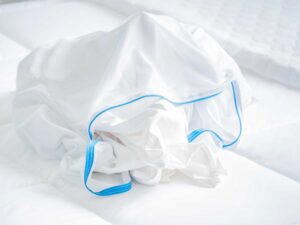Mattress Pad vs. Mattress Protector
Disclosure: By clicking on the product links in this article, Mattress Nerd may receive a commission fee at no cost to you, the reader. Read full disclosure statement.
Not long ago, shopping for a mattress and accessories to go with it was simple. As the bedding industry has become more saturated and technologically-advanced, that world has transformed into one of choice and, for some, overwhelm. It can be confusing to figure out the differences between products and brands, even when it comes to mattress pads and toppers. If you need to understand what is a mattress pad, what is a mattress protector, the pros and cons of each, and which might be right for you, you’ll find the information you need in this guide.
What is a Mattress Pad?
The traditional definition of a mattress pad is a barrier between the sleeper and the mattress cover. Pads add a thin layer (usually about one inch) of comfort and are typically attached to the mattress via a fitted sheet or strap design. You may have heard of the term mattress topper as well. Think of toppers as an upgraded, thicker (three to four inches) version of a pad. Toppers can weigh up to 30 or 40 pounds and, like pads, sit on top of your mattress but may have straps to secure them.
The main goal of mattress pads and toppers is to increase the comfort or adjust the firmness of the sleeping surface. Shoppers benefit from and gravitate toward them for a variety of reasons:
- They find additional support and comfort for personal or medical reasons.
- Their old mattress is uncomfortable but they’re not ready to replace it.
- They desire the protectional benefits of a mattress protector but with added comfort.
- The current mattress is too firm or too soft, and they want to adjust the firmness level.
- Pads and protectors help keep contaminants like allergens and bacteria off the mattress’ surface.
Mattress toppers will generally cost more than mattress pads, as they’re filled with more material. The fill of toppers can vary and include anything from down to memory foam, cotton, latex, and more. If you’re deciding between a mattress topper and a mattress pad, it will come down to how much you want to change the feel of the surface of your mattress as well as your budget. A topper will cost roughly $50 to $400, and a pad will cost roughly $50 to $100.
Here are some of the drawbacks of mattress pads and toppers to consider:
- Many pads and toppers don’t protect against spills and stains.
- Thin, more affordable pads won’t improve softness or comfort to a noticeable degree.
- Both pads and toppers are limited with regard to how much they can change a bed’s feel, especially when compared to a brand new mattress.
What is a Mattress Protector?
Mattress protectors are cotton or polyester sheets designed to keep a mattress’ surface clean. Usually one inch or less thick and less than five pounds heavy, they’re much thinner and lightweight than pads and toppers. Protectors are typically secured with elastic, like a fitted sheet, but some will zip over the mattress and are called “full encasement” protectors.
Most protectors are waterproof, helping wick perspiration and moisture away from the mattress. A protector won’t alter the feel of the bed in a significant way since its primary purpose is to keep allergens, dust mites, and bacteria from harming the mattress. Here are a few reasons someone might invest in a mattress protector:
- Serve as contaminant barrier, protecting against dust mites, bacteria, and water.
- Most are waterproof or water-resistant, shielding the mattress from perspiration, urine, spills, and other liquids.
- Keep mattresses from retaining moisture that could lead to mold in humid regions.
- Can aid in keeping mattress toppers in place.
- Most are hypoallergenic and won’t trigger sleeper allergies.
- Help prevent bed bugs infestations.
- They extend the life of your mattress, protecting it from the various issues and elements listed above.
Mattress protectors are generally less expensive than mattress pads and toppers. Buyers can expect to spend roughly $15 to $70 on a protector. It’s important to note that a protector will not improve the feel or comfort of your existing mattress.
Here are some of the other drawbacks to consider when deciding whether a mattress protector is right for you:
- Depending on the materials the protector is made with, it may sleep hot.
- Protectors with waterproof qualities may cause a crinkling noise when you move around at night.
- Protectors should be washed weekly and, as a result, can degrade quickly.
Which is Right for You?
The decision between a mattress pad or topper and a mattress protector will ultimately come down to your needs. If you’ve recently purchased a new mattress and want to protect your investment, a mattress protector can do that for you. If you have an old bed or are unhappy with your current mattress’ comfort or firmness level, a mattress pad or topper in the appropriate thickness and material can help improve your sleep experience.


